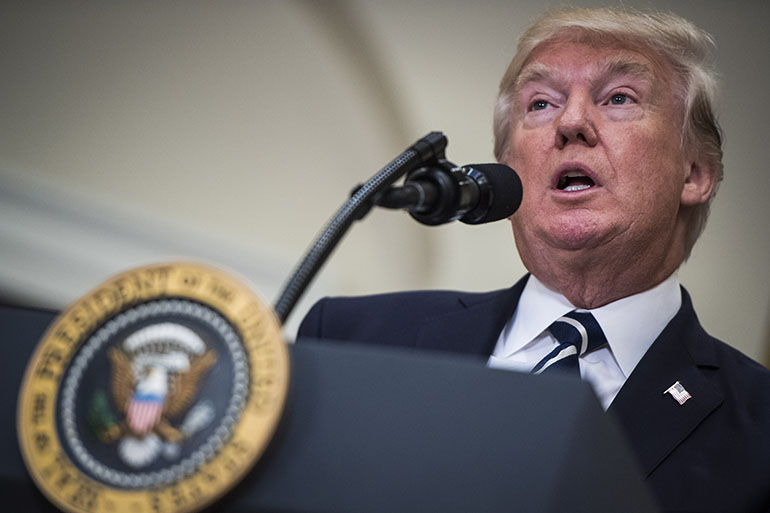
The pharmaceutical industry could see windfall profits from a little-noticed tweak to the insurance market tucked into the Trump administration’s draft executive order on drug prices, experts say.
The short, technical paragraph calls for the Internal Revenue Service to allow patients with high-deductible health plans to receive care for chronic diseases, including drugs, before meeting their deductibles.
This allowance, known as a “safe harbor,” could be welcome news for patients with chronic conditions like diabetes or asthma stuck with skimpy plans. For example, a diabetes patient could fill her prescription for insulin with just a copay, even if she hadn’t spent enough on medical bills for her insurance coverage to kick in. But in the long term, experts say, extending a safe harbor to chronic care would encourage more employers to adopt these skimpy plans, while shielding the pharmaceutical industry from pressure to lower drug costs.
“It’s hard to view this as anything but a substantial win for pharma,” said Kim Monk, a partner and pharmaceutical expert at Capital Alpha Partners, which tracks laws and regulations for financial institutions.
High-deductible health plans have surged in the past five years. The U.S. Centers for Disease Control and Prevention estimates almost 40 percent of patients ages 18-64 must pay $1,300 before receiving insurance coverage, and families must pay at least $2,600. And when faced with high drug prices, more of these patients skip filling prescriptions. Of the millions of insured Americans who struggle to pay their medical bills, 41 percent skip filling a prescription due to cost according to a 2016 Kaiser Family Foundation poll. (Kaiser Health News is an editorially independent program of the foundation.)
These high-deductible health plans are likely to grow if the GOP health plan becomes law, according to the Congressional Budget Office.
But should the White House call on the IRS to offer a safe harbor for chronic disease medications, patients may visit the pharmacy more often despite the high deductibles.
“Yes, this provision could alleviate some of the pharmaceutical industry’s concerns about the increased cost-sharing patients with high-deductible plans could expect under the Republican health care bills,” said Rachel Sachs, an associate professor of law at Washington University in St. Louis who studies the pharmaceutical industry. “As the draft order notes, if high-deductible plan enrollees with chronic conditions can lower out-of-pocket costs for some of their medications, they will be more likely to adhere to their treatment regimens.”
The language of the draft executive order could signal a significant expansion of drug coverage for the growing population with high-deductible plans, according to Stacie Dusetzina, assistant professor of pharmacy and public health at the University of North Carolina-Chapel Hill. Under the Affordable Care Act, preventive drugs were covered before the deductible was met, but the provision was “quite narrowly defined and did not include medications that are used to prevent the progression of disease,” Dusetzina said. “Instead, it was more about preventing the disease altogether. In that way, the executive order could have a big impact on patient access to drugs.”
But unlike coverage under Medicaid or under a plan with a higher actuarial value, the IRS would determine what care and medications are covered. It’s not yet clear whether the safe harbor would extend to essential HIV drugs, insulin or expensive drugs that treat rare diseases.
“You’re asking the IRS to define something the IRS has never had to define before,” said Monk.
The draft executive order explains that the expanded coverage is “for the purpose of helping patients adhere to clinical regimes and thereby reducing the cost of care.” For instance, a patient who can afford an inhaler is less likely to be admitted to the hospital for wheezing. But whether this compliance reduces the cost of care in the long term depends on treatment costs and drug costs, Sachs said.
The safe harbor for chronic care has been championed by the Smarter Health Care Coalition, a partnership linking industry heavyweights including America’s Health Insurance Plans (AHIP), the insurers’ lobbying group; the U.S. Chamber of Commerce; Novo Nordisk; and Pfizer.
The safe harbor will make high-deductible health plans more attractive to employers, according to Tracy Watts, a senior partner at benefits firm Mercer, which could prompt insurers to supply them. “Such a change would go a long way toward encouraging more employers to offer [high-deductible] plans and would boost enrollment,” Watts wrote in a blog post.
The White House has not issued an official executive order on drug prices yet. The draft order, first obtained by The New York Times, has been overshadowed by the political drama over the health bill on the Hill.
Major trade groups have largely avoided shedding political capital on the congressional health care fight — among the most conspicuously absent: PhRMA, the Biotechnology Innovation Organization and the Association for Accessible Medicines, the generic-medicines lobby.
Pharmaceutical companies would see a $2.7 billion annual tax break, but that money would be eclipsed by losses in revenue from Medicaid and Medicare, as well as the drop in demand for health care from the millions of newly uninsured, Moody’s concluded in March.
PhRMA won’t yet say whether it supports the chronic-care safe harbor. “We can’t speak to what the administration will do on this issue and don’t think it would be appropriate to speculate,” said Holly Campbell, deputy vice president of public affairs at PhRMA.
This story was produced by Kaiser Health News, an editorially independent program of the Kaiser Family Foundation.
KHN’s coverage of prescription drug development, costs and pricing is supported in part by the Laura and John Arnold Foundation.
Kaiser Health News (KHN) is a national health policy news service. It is an editorially independent program of the Henry J. Kaiser Family Foundation.